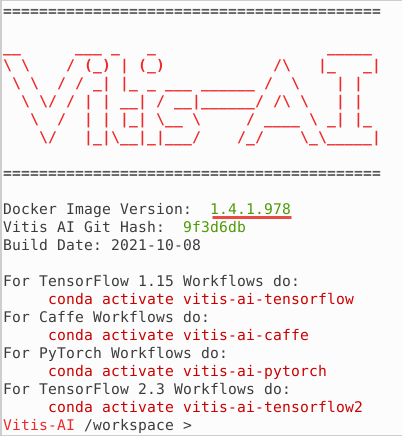Running a pre-built example on Amazon AWS F1
In this lab you will use a pre-built TensorFlow framework supported model to validate installation on the F1 instance that has a Xilinx FPGA board.
You should have an instance with the docker image installed and Vitis-AI 1.4.1 Git repository cloned. If not done, then refer to AWS_README.
Open a terminal window after logging in into the instance.
You can download model files (board specific pre-compiled or board independent source files) to run the available downloader.py located in Vitis-AI_1_4_1/models/AI-Model-Zoo directory.
Execute the following commands to download the U200 specific pre-compiled files:
cd /home/ubuntu/Vitis-AI_1_4_1/models/AI-Model-Zoo/
python3 downloader.py
You will see output like:

Type tf inceptionv1 and hit Enter. The available selections will be displayed.

Note 1 is for the board independent source files, 7 is for the U200 specific compiled files, 2 to 6 are for the other boards specific options.
Type 7 and hit Enter to download the tar file (inception_v1_tf-u200-u250-r1.4.0.tar.gz). Extract the downloaded file to get inception_v1_tf directory and associated files.
tar -xvf inception_v1_tf-u200-u250-r1.4.0.tar.gz
Launch Docker Container
Start the docker image by executing the following commands:
cd /home/ubuntu/Vitis-AI_1_4_1
./docker_run.sh xilinx/vitis-ai-cpu:1.4.1.978
Hit the enter key six times until you see a message to agree to the terms. Press y and hit enter to download the docker files. It may take few minutes to download the image during the first invocation. You will see the docker shell:

Activate conda for TensorFlow.
conda activate vitis-ai-tensorflow
Note that the docker shell’s command prompt indicates that the tensorflow is activated.
(vitis-ai-tensorflow) Vitis-AI /workspace>
Note that /workspace of docker image maps to the /home/ubuntu/Vitis-AI_1_4_1 directory in the Ubuntu terminal.
Change the directory to go to the untared directory.
cd ./models/AI-Model-Zoo/inception_v1_tf
Note the three files provided:
inception_v1_tf.prototxt inception_v1_tf.xmodel md5sum.txt.
The inception_v1_tf.xmodel is the compiled model for the DPUCADF8H DPU.
Copy the necessary source files directory (src), a shell script to build the project (build.sh), and words.txt which describes various objects labels from the example directory provided as part of the repository. Finally, build the project.
cp -r ../../../examples/DPUCADF8H/tf_inception_v1/* .
./build.sh
The build.sh script will compile the source files and generate the inception_example executable.
Download a minimal validation set for Imagenet2012 using Collective Knowledge (CK) by executing the following commands:
Note: User is responsible for the use of the downloaded content and compliance with any copyright licenses.
mkdir image
python -m ck pull repo:ck-env
python -m ck install package:imagenet-2012-val-min
python -m ck install package:imagenet-2012-aux --tags=from.berkeley
head -n 500 ~/CK-TOOLS/dataset-imagenet-ilsvrc2012-aux-from.berkeley/val.txt > ./image/val.txt
cp ~/CK-TOOLS/dataset-imagenet-ilsvrc2012-val-min/*.JPEG image/
Note that ~ is the home directory of the docker image which maps to /home/vitis-ai-user/.
Source the DPU xclbin.
source /workspace/setup/alveo/setup.sh DPUCADF8H
After sourcing the setup.sh in the above command, you should see the XCLBIN_PATH and XLNX_VART_FIRMWARE defined.
XCLBIN_PATH = /opt/xilinx/overlaybins/DPUCADF8H
XLNX_VART_FIRMWARE = /opt/xilinx/overlaybins/DPUCADF8H/dpu-aws.xclbin
Run the inception_example application with the compiled model and the validation set by executing the following command:
./inception_example inception_v1_tf.xmodel ./image
The compiled model will be loaded in the DPU and the application will run in hardware generating output like:
Image : ILSVRC2012_val_00000498.JPEG
top[0] prob = 0.544102 name = common newt, Triturus vulgaris
top[1] prob = 0.094551 name = centipede
top[2] prob = 0.064984 name = eft
top[3] prob = 0.023906 name = spotted salamander, Ambystoma maculatum
top[4] prob = 0.014500 name = European fire salamander, Salamandra salamandra
Image : ILSVRC2012_val_00000237.JPEG
top[0] prob = 0.450742 name = English foxhound
top[1] prob = 0.351039 name = Walker hound, Walker foxhound
top[2] prob = 0.047508 name = Great Dane
top[3] prob = 0.028815 name = English setter
top[4] prob = 0.012012 name = German short-haired pointer
Image : ILSVRC2012_val_00000073.JPEG
top[0] prob = 0.290455 name = kite
top[1] prob = 0.176170 name = sulphur-crested cockatoo, Kakatoe galerita, Cacatua galerita
top[2] prob = 0.106852 name = vulture
top[3] prob = 0.044543 name = papillon
top[4] prob = 0.034690 name = bald eagle, American eagle, Haliaeetus leucocephalus
The output shows the image file that is being evaluated and top five probabilities of the classification. The names are derived from val.txt file which is part of the downloaded validation set in the image directory.
You may want to close the docker image by typing exit in the image console.
Now that we have verified that we can execute the application in hardware, we can explore first framework example.
Copyright© 2022 Xilinx